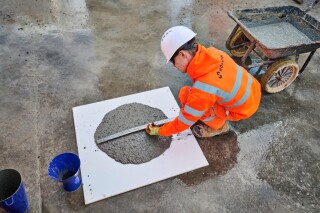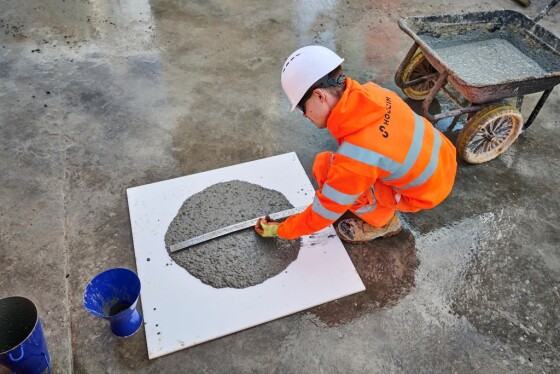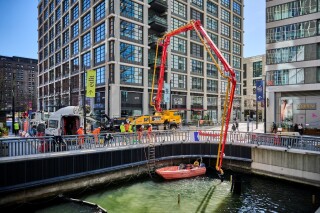
Holcim UK has created an innovative concrete mix using recycled coffee grounds to support a 12-metre high sculpture of a blue whale in London’s Canary Wharf.
The Whale on the Wharf (Skyscraper) by StudioKCA, unveiled this week, was created from five tonnes of plastic waste recovered from the Atlantic and Pacific oceans and has been sited in a wet dock in Canary Wharf’s Wood Wharf district.
But the four-storey-high structure required firm counterweight foundations to keep it and its frame in place.
Canary Wharf Group turned to Holcim UK to develop an innovative concrete to support it and the circular economy message that the sculpture embodies.
Holcim experts devised a concrete mix containing biochar sourced from coppiced UK fast growing hard woods and used coffee grounds from Canary Wharf’s cafes and restaurants to form the structural supports to anchor the sculpture in place.
Five loads – 32 cubic metres – were mixed and batched at Holcim UK’s Battersea Readymix plant before delivery to site. A specialist civil engineering diving company, DiveCo Marine, then pumped the concrete into place under the water’s surface.
Holcim UK, working with counterparts at the Holcim Innovation Centre in Lyon, has been testing the use of biochar in readymix concrete for a number of years. Biochar is widely used in agriculture and is produced by heating biomass, typically sourced from surplus wood, at temperature and in the absence of oxygen, through a process called pyrolysis. The result is a black carbon-rich material like charcoal. Similarly, spent coffee grounds can be turned into a carbon-rich biochar when treated through pyrolysis.


The process of creating biochar can help prevent the formation of greenhouse gases which are generated when biomass waste (and used coffee) is sent to landfill and naturally degrades, releasing carbon dioxide and in some instances methane.

When biochar is added to concrete, the sequestered carbon is removed from the carbon cycle for a long time. Using biochar means less virgin or primary aggregate is used and less waste is sent to landfill or incinerators.
Jasen Gauld, national concrete solutions and product development director at Holcim UK, said: “We have a really good ongoing relationship with Canary Wharf Group. They approached us regarding the project and the need for an innovative and new concrete to support The Whale on the Wharf. It was essential that the concrete conveyed a new message of circularity, sustainability, and a bold approach to tackling carbon.
“Collaborating with the Holcim Innovation Centre in Lyon, we have been developing and testing the use of biochar in concrete, confident it would be an ideal solution. It’s a technology we are really excited about, not just because it helps sequester carbon and lower the embodied carbon in concrete, but also because it aligns so well with the circular economy.”


He added: “The final ready-mix concrete is fully code-compliant and performs just as expected. Plus, we have incorporated a biomass material that can lock CO2 into the concrete, while recycling waste that would normally decompose and release greenhouse gases.”
Jonathan Ly, director for structures at Canary Wharf Group, said: “This is a pioneering moment for CWG and our partners. A UK first, the Whale on the Wharf (Skyscraper) project has provided us with a unique opportunity to test this innovative use of spent coffee grounds as a material in biochar, moving us ever closer to our net zero goals.
“Thanks to CWG’s in-house waste management system, we are able to turn something once considered as waste, into a fruitful building material, saving significant carbon from entering the atmosphere.
“We are proud to be the first UK developer to use this coffee biochar mix in our concrete, embedding the principles of a circular economy in our design and construction process. I can’t wait to see where we can take this in our future projects and prove what we can do when working as a collective.”
Got a story? Email news@theconstructionindex.co.uk
#Coffee #concrete #supports #Canary #Wharf #sculpture